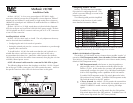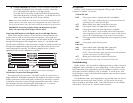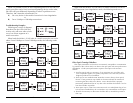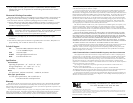
3
4
nn
In Force-100 mode, the McBasic 10/100 configures specifically as
a 100BASE-TX/100BASE-SX or FX media converter. Note that
Force-100 implies the rejection of 10 Mbps signals.
To enable Force-100 mode, set Dip switch 6 to the ON position
(Dip switch 4 must be in the OFF position). To disable Force-100
mode, move Dip switch 6 to OFF (factory default).
Note: Force mode should be used when any of the devices connected to the
media converters DO NOT support Auto-Negotiation. Do NOT enable both
Dip switches 5 and 6. Only one switch should be enabled at any given time.
IMPORTANT: It necessary to power down and then power up again
before the above Dip switch changes will take effect!
Connecting Half Duplex or Full Duplex and 10 or 100 Mbps Devices
When connecting two McBasic 10/100 media converters between two
stations (devices such as switches, hubs and repeaters), unless both end
stations are set to the same speed/duplex, one end station MUST be settable
through PNP/Transparent (Auto-Negotiation) mode (i.e., can handle both
10/100 and/or HDX/FDX). If the end stations Duplex or speed cannot be set
through Auto-Negotiation mode, then both end stations must be set for the
same configurations manually. The following diagram shows a typical
application with several configuration scenarios:
Note:
McBasic 10/100 cannot be manually set for Half or Full Duplex.
Twisted Pair Crossover/Pass-Through Switch
The twisted pair port on McBasic 10/100 has one RJ-45 connector for a
single shielded or unshielded twisted pair link segment, and features a push-
button, located next to the twisted pair connector, for selecting a crossover
workstation connection or pass-through repeater/hub connection. Select a
pass-through connection by pressing the push-button IN. A crossover
connection is selected when the push-button is OUT.
LED Operation
McBasic 10/100 features several diagnostic LEDs per port. The LED
functions for McBasic 10/100 are:
Twisted Pair Port
LNK Glows green when a twisted pair link is established
NOTE: Fiber optic cable must also be connected before the
twisted pair ports Link LED will light.
ACT Blinks yellow when data is detected on the port
100 Glows green when 100 Mbps data is detected
LFD Glows green when Link Fault Detection is available
NOTE: This feature is only available when PNP/Transparent
(Auto-Negotiation) mode is enabled. For more on this feature,
refer to the Troubleshooting section later in this document.
AN Glows green when PNP/Transparent (Auto-Negotiation) mode
is enabled
PWR Glows green when unit has power
Fiber Port
100 Glows yellow when 100 Mbps data is detected
LNK Glows green when a fiber link is established
NOTE: The twisted pair cable must also be connected before
the fiber optic ports Link LED will light.
ACT Blinks green when data is detected on the port
NOTE: The fourth LED in this stack in reserved for future use.
Troubleshooting
Ideally, McBasic 10/100 should be implemented into a media conversion
installation where both sides are Auto-Negotiating. In this scenario where
PNP/Transparent (Auto-Negotiation) mode is enabled on McBasic 10/100,
the feature Link Fault Detection (LFD) is available. If a fault occurs, Link
Fault Detection carries the link fault through the entire media conversion,
dropping all Link LEDs.
For installations where Auto-Negotiation is not possible from one end of
the media conversion to the other, McBasic 10/100 can be forced into
either 10 Mbps or 100 Mbps mode. Link Fault Detection is not available
and McBasic 10/100 acts as a normal media converter.






